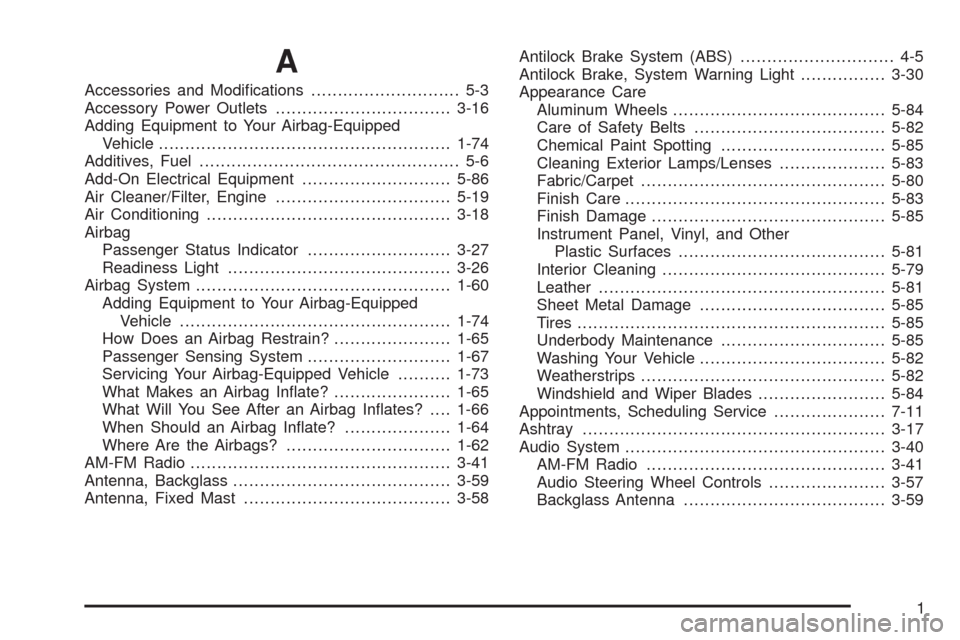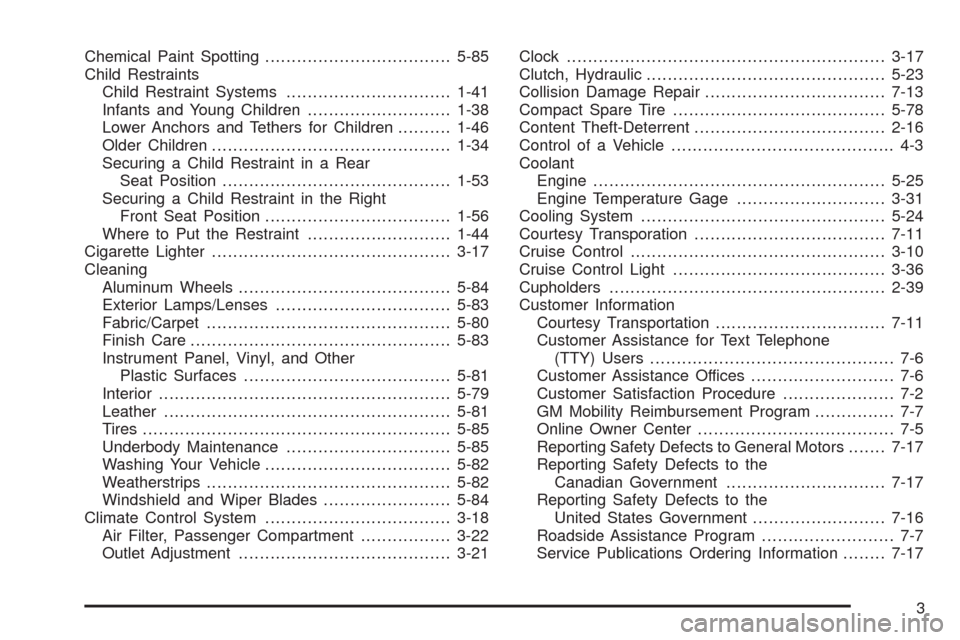2009 CHEVROLET AVEO light
[x] Cancel search: lightPage 287 of 354

Notice:When the compact spare is installed, do
not take the vehicle through an automatic car wash
with guide rails. The compact spare can get
caught on the rails which can damage the tire,
wheel and other parts of the vehicle.
Do not use your compact spare on other vehicles.
Do not mix your compact spare tire or wheel with other
wheels or tires. Keep your spare tire and its wheel
together.
Notice:Tire chains will not �t the compact spare.
Using them can damage the vehicle and can damage
the chains too. Do not use tire chains on the
compact spare.
Appearance Care
Interior Cleaning
The vehicle’s interior will continue to look its best if it is
cleaned often. Although not always visible, dust and
dirt can accumulate on the upholstery. Dirt can damage
carpet, fabric, leather, and plastic surfaces. Regular
vacuuming is recommended to remove particles from the
upholstery.It is important to keep the upholstery from becoming
and remaining heavily soiled. Soils should be removed
as quickly as possible. The vehicle’s interior may
experience extremes of heat that could cause stains to
set rapidly.
Lighter colored interiors may require more frequent
cleaning. Use care because newspapers and garments
that transfer color to home furnishings may also
transfer color to the vehicle’s interior.
When cleaning the vehicle’s interior, only use cleaners
speci�cally designed for the surfaces being cleaned.
Permanent damage may result from using cleaners on
surfaces for which they were not intended. Use glass
cleaner only on glass. Remove any accidental over-spray
from other surfaces immediately. To prevent over-spray,
apply cleaner directly to the cleaning cloth.
Notice:Using abrasive cleaners when cleaning
glass surfaces on the vehicle, could scratch
the glass and/or cause damage to the rear window
defogger. When cleaning the glass on the vehicle,
use only a soft cloth and glass cleaner.
Many cleaners contain solvents that may become
concentrated in the vehicle’s breathing space. Before
using cleaners, read and adhere to all safety instructions
on the label. While cleaning the vehicle’s interior,
maintain adequate ventilation by opening the vehicle’s
doors and windows.
5-79
Page 290 of 354

Care of Safety Belts
Keep belts clean and dry.
{CAUTION:
Do not bleach or dye safety belts. It may severely
weaken them. In a crash, they might not be able
to provide adequate protection. Clean safety belts
only with mild soap and lukewarm water.
Weatherstrips
Silicone grease on weatherstrips will make them last
longer, seal better, and not stick or squeak. Apply silicone
grease with a clean cloth. During very cold, damp
weather frequent application may be required.
Washing Your Vehicle
The best way to preserve the vehicle’s �nish is to keep it
clean by washing it often.Notice:Certain cleaners contain chemicals that can
damage the emblems or nameplates on the vehicle.
Check the cleaning product label. If it states that it
should not be used on plastic parts, do not use it on
the vehicle or damage may occur and it would not be
covered by the warranty.
Do not wash the vehicle in direct sunlight. Use a car
washing soap. Do not use cleaning agents that
are petroleum based or that contain acid or abrasives,
as they can damage the paint, metal or plastic on
the vehicle. Approved cleaning products can be obtained
from your dealer/retailer. Follow all manufacturers’
directions regarding correct product usage, necessary
safety precautions and appropriate disposal of any
vehicle care product.
Rinse the vehicle well, before washing and after to
remove all cleaning agents completely. If they are
allowed to dry on the surface, they could stain.
Dry the �nish with a soft, clean chamois or an all-cotton
towel to avoid surface scratches and water spotting.
High pressure car washes may cause water to enter the
vehicle. Avoid using high pressure washes closer
than 12 inches (30 cm) to the surface of the vehicle.
Use of power washers exceeding 1,200 psi (8 274 kPa)
can result in damage or removal of paint and decals.
5-82
Page 297 of 354

Fuses Usage
CIGAR Cigar Lighter
CLUSTERBrake Switch, TPMS, Anti-Theft
Module
DEFOG
MIRRORPower Mirror Unit, A/C Switch
RR DEFOG Rear Defog
DOOR LOCK Door Lock
NA DRL NA DRL Circuit
MIRROR/
SUNROOFMirror Control Switch, Room Lamp,
A/C Switch
EMS 1Engine Room Fuse Block, TCM,
VSS, Fuel Pump
EMS 2 Stoplamp Switch
HORN Horn
OBD DLC, Immobilizer
CLUSTER/
ROOM LAMPTrunk Room Lamp, Trunk Open
Switch, IPC, Room Lamp
SDM Sensing and Diagnostic Module
SOKET Power JackFuses Usage
STOP LAMP Brake Switch
SUNROOF Sunroof Module (Option)
T/SIG Hazard Switch
WIPER Wiper Switch, Wiper Motor
Engine Compartment Fuse Block
The engine compartment fuse block is located on the
driver side of the vehicle, near the battery. See
Engine Compartment Overview on page 5-14for more
information on location.
Notice:Spilling liquid on any electrical components
on the vehicle may damage it. Always keep the
covers on any electrical component.
To access the fuses, press in the side �aps to release
the cover. To reinstall the cover, push the cover until it is
secure.
5-89
Page 306 of 354

Scheduled Maintenance
When the change engine oil light displays, service is
required for the vehicle. Have the vehicle serviced
as soon as possible within the next 600 miles
(1 000 km). It is possible that, if driving under the best
conditions, the engine oil life system may not indicate
that vehicle service is necessary for over a year.
However, the engine oil and �lter must be changed at
least once a year and at this time the system must
be reset. Your dealer/retailer has trained service
technicians who will perform this work using genuine
parts and reset the system.
If the engine oil life system is ever reset accidentally,
service the vehicle within 3,000 miles (5 000 km)
since the last service. Remember to reset the oil life
system whenever the oil is changed. See for information
on the Engine Oil Life System and resetting the
system.When the change engine oil light displays, certain
services, checks, and inspections are required.
Required services are described in the following for
“MaintenanceI” and “MaintenanceII.” Generally,
it is recommended that the �rst service be
MaintenanceI, the second service be MaintenanceII,
and then alternate MaintenanceIand MaintenanceII
thereafter. However, in some cases, MaintenanceIImay
be required more often.
MaintenanceI— Use MaintenanceIif the change
engine oil light displays within 10 months since
the vehicle was purchased or MaintenanceIIwas
performed.
MaintenanceII— Use MaintenanceIIif the previous
service performed was MaintenanceI. Always use
MaintenanceIIwhenever the change engine oil light
displays 10 months or more since the last service or if
the message has not come on at all for one year.
6-4
Page 310 of 354

Maintenance Footnotes
†The U.S. Environmental Protection Agency or the
California Air Resources Board has determined that the
failure to perform this maintenance item will not nullify
the emission warranty or limit recall liability prior to
the completion of the vehicle’s useful life. We, however,
urge that all recommended maintenance services be
performed at the indicated intervals and the
maintenance be recorded.
(a)Visually inspect brake lines and hoses for proper
hook-up, binding, leaks, cracks, chafing, etc. Inspect
disc brake pads for wear and rotors for surface
condition. Inspect drum brake linings/shoes for wear or
cracks. Inspect other brake parts, including drums,
wheel cylinders, calipers, parking brake, etc.
(b)Visually inspect front and rear suspension and
steering system for damaged, loose, or missing parts
or signs of wear. Inspect power steering cables for
proper hook-up, binding, cracks, chafing, etc.
(c)Visually inspect hoses and have them replaced if
they are cracked, swollen, or deteriorated. Inspect
all pipes, fittings and clamps; replace with genuine
parts as needed. To help ensure proper operation,
a pressure test of the cooling system and pressure cap
and cleaning the outside of the radiator and air
conditioning condenser is recommended at least
once a year.(d)Inspect wiper blades for wear, cracking, or
contamination. Clean the windshield and wiper blades,
if contaminated. Replace wiper blades that are worn
or damaged. See Windshield Wiper Blade Replacement
on page 5-50 and Windshield and Wiper Blades on
page 5-84 for more information.
(e)Make sure the safety belt reminder light and safety
belt assemblies are working properly. Look for any
other loose or damaged safety belt system parts. If you
see anything that might keep a safety belt system
from doing its job, have it repaired. Have any torn or
frayed safety belts replaced. Also see Checking
the Restraint Systems on page 1-75.
(f)Lubricate all key lock cylinders, door hinges and
latches, hood hinges and latches, and trunk lid hinges
and latches. More frequent lubrication may be required
when exposed to a corrosive environment. Applying
silicone grease on weatherstrips with a clean cloth will
make them last longer, seal better, and not stick or
squeak.
(g)Visually inspect belt for fraying, excessive cracks, or
obvious damage. Replace belt if necessary.
6-8
Page 343 of 354

A
Accessories and Modi�cations............................ 5-3
Accessory Power Outlets.................................3-16
Adding Equipment to Your Airbag-Equipped
Vehicle.......................................................1-74
Additives, Fuel................................................. 5-6
Add-On Electrical Equipment............................5-86
Air Cleaner/Filter, Engine.................................5-19
Air Conditioning..............................................3-18
Airbag
Passenger Status Indicator...........................3-27
Readiness Light..........................................3-26
Airbag System................................................1-60
Adding Equipment to Your Airbag-Equipped
Vehicle...................................................1-74
How Does an Airbag Restrain?......................1-65
Passenger Sensing System...........................1-67
Servicing Your Airbag-Equipped Vehicle..........1-73
What Makes an Airbag In�ate?......................1-65
What Will You See After an Airbag In�ates?....1-66
When Should an Airbag In�ate?....................1-64
Where Are the Airbags?...............................1-62
AM-FM Radio.................................................3-41
Antenna, Backglass.........................................3-59
Antenna, Fixed Mast.......................................3-58Antilock Brake System (ABS)............................. 4-5
Antilock Brake, System Warning Light................3-30
Appearance Care
Aluminum Wheels........................................5-84
Care of Safety Belts....................................5-82
Chemical Paint Spotting...............................5-85
Cleaning Exterior Lamps/Lenses....................5-83
Fabric/Carpet..............................................5-80
Finish Care.................................................5-83
Finish Damage............................................5-85
Instrument Panel, Vinyl, and Other
Plastic Surfaces.......................................5-81
Interior Cleaning..........................................5-79
Leather......................................................5-81
Sheet Metal Damage...................................5-85
Tires..........................................................5-85
Underbody Maintenance...............................5-85
Washing Your Vehicle...................................5-82
Weatherstrips..............................................5-82
Windshield and Wiper Blades........................5-84
Appointments, Scheduling Service.....................7-11
Ashtray.........................................................3-17
Audio System.................................................3-40
AM-FM Radio.............................................3-41
Audio Steering Wheel Controls......................3-57
Backglass Antenna......................................3-59
1
Page 344 of 354

Audio System (cont.)
Fixed Mast Antenna.....................................3-58
Radio Reception..........................................3-58
Radio with CD............................................3-46
Automatic Transmission
Fluid..........................................................5-21
Operation...................................................2-22
B
Backglass Antenna..........................................3-59
Battery..........................................................5-37
Inadvertent Power Saver..............................3-16
Brake
Emergencies................................................ 4-6
Brake Fluid....................................................5-34
Brakes..........................................................5-34
System Warning Light..................................3-28
Braking........................................................... 4-4
Braking in Emergencies..................................... 4-6
Break-In, New Vehicle.....................................2-18
Bulb Replacement
Center High-Mounted Stoplamp (CHMSL)........5-47
Daytime Running Lamp................................3-14
Fog Lamp ..................................................3-15
Front Turn Signal, Sidemarker and
Parking Lamps.........................................5-45Bulb Replacement (cont.)
Halogen Bulbs............................................5-43
Headlamp Aiming........................................5-43
Headlamps.........................................5-43, 5-44
License Plate Lamps....................................5-49
Replacement Bulbs......................................5-49
Taillamps, Turn Signal, Sidemarker,
Stoplamps, and Back-Up Lamps.................5-48
Buying New Tires...........................................5-64C
California Fuel.................................................. 5-6
California Perchlorate Materials Requirements....... 5-4
California Proposition 65 Warning....................... 5-4
Canadian Owners................................................ ii
Capacities and Speci�cations............................5-93
Carbon Monoxide.............................2-8, 2-32, 4-13
Care of
Safety Belts................................................5-82
CD, MP3 .......................................................3-54
Center High-Mounted Stoplamp (CHMSL)...........5-47
Chains, Tire...................................................5-68
Charging System Light....................................3-28
Check
Engine Lamp..............................................3-32
Checking Things Under the Hood......................5-11
2
Page 345 of 354

Chemical Paint Spotting...................................5-85
Child Restraints
Child Restraint Systems...............................1-41
Infants and Young Children...........................1-38
Lower Anchors and Tethers for Children..........1-46
Older Children.............................................1-34
Securing a Child Restraint in a Rear
Seat Position...........................................1-53
Securing a Child Restraint in the Right
Front Seat Position...................................1-56
Where to Put the Restraint...........................1-44
Cigarette Lighter.............................................3-17
Cleaning
Aluminum Wheels........................................5-84
Exterior Lamps/Lenses.................................5-83
Fabric/Carpet..............................................5-80
Finish Care.................................................5-83
Instrument Panel, Vinyl, and Other
Plastic Surfaces.......................................5-81
Interior.......................................................5-79
Leather......................................................5-81
Tires..........................................................5-85
Underbody Maintenance...............................5-85
Washing Your Vehicle...................................5-82
Weatherstrips..............................................5-82
Windshield and Wiper Blades........................5-84
Climate Control System...................................3-18
Air Filter, Passenger Compartment.................3-22
Outlet Adjustment........................................3-21Clock............................................................3-17
Clutch, Hydraulic.............................................5-23
Collision Damage Repair..................................7-13
Compact Spare Tire........................................5-78
Content Theft-Deterrent....................................2-16
Control of a Vehicle.......................................... 4-3
Coolant
Engine.......................................................5-25
Engine Temperature Gage............................3-31
Cooling System..............................................5-24
Courtesy Transporation....................................7-11
Cruise Control................................................3-10
Cruise Control Light........................................3-36
Cupholders....................................................2-39
Customer Information
Courtesy Transportation................................7-11
Customer Assistance for Text Telephone
(TTY) Users.............................................. 7-6
Customer Assistance Offices........................... 7-6
Customer Satisfaction Procedure..................... 7-2
GM Mobility Reimbursement Program............... 7-7
Online Owner Center..................................... 7-5
Reporting Safety Defects to General Motors.......7-17
Reporting Safety Defects to the
Canadian Government..............................7-17
Reporting Safety Defects to the
United States Government.........................7-16
Roadside Assistance Program......................... 7-7
Service Publications Ordering Information........7-17
3